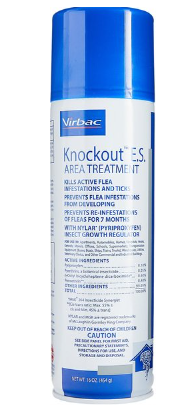
Kate Barrington / Cats.com
Fleas carry pathogens and diseases that can be transmitted to your cat. By choosing the right flea treatment, you can spare your cat from the itching and irritation that comes with a flea infestation. You’ll also protect them from some of the more serious consequences of being a host to fleas.
Flea treatments can be dangerous if you choose the wrong one or use it improperly. In this guide, we’ll cover the different types of cat flea treatments, discovering which ones are safe and which are toxic to your cat. You’ll also learn how to choose the best option for your unique situation.
At a Glance 11 Best Cat Flea Treatments To Buy





Advantage II Flea Spot Treatment for Cats
- Kills adult fleas, eggs, and larvae
- Easy to apply topical treatment
- One dose lasts 30 days

Revolution Plus Topical Solution for Cats
- One dose provides 30 days of protection
- Effective against fleas, ticks, and mites
- Three formulations for cats 2.8-22 pounds

TevraPet FirstAct Plus Flea & Tick Treatment for Cats
- Costs less than $6 per dose
- One dose lasts up to 6 weeks
- Kills adult fleas, eggs, and larvae

PetArmor CapAction Flea Tablets for Cats
- Oral tablet begins working within 30 minutes
- Safe for kittens 4 weeks and older
- Costs $2 less per tablet than Capstar

Bravecto Topical Solution for Cats (12-Week Supply)
- One dose provides up to 12 weeks of protection
- Multiple concentrations for cats up to 27.5 pounds
- Effective against both fleas and ticks

Novartis Capstar Oral Flea Treatment for Cats
- Starts killing fleas within 30 minutes
- Gentle formulation safe for daily use
- Safe for kittens as young as 4 weeks

Cheristin Flea Spot Treatment for Cats
- Available without a prescription
- Effective against adult fleas, ticks, and mites
- One dose provides up to 6 weeks of protection

Seresto Flea & Tick Collar for Cats
- Offers up to 8 months of flea and tick prevention
- Low-maintenance alternative to spot-on treatments
- Effective against adult fleas, larvae, and eggs

Hartz Groomer’s Best Flea Comb for Dogs & Cats
- Extra-fine teeth to catch adult fleas and eggs
- Ergonomic handle for comfortable use
- Inexpensive, costs less than $6

Adams Plus Flea & Tick Shampoo with Precor for Dogs and Cats
- Kills adult fleas, eggs, and larvae on contact
- Contains skin-soothing ingredients
- Insect growth regulator may kill fleas for up to 28 days

Virbac Knockout E.S. Area Treatment Carpet Spray
- Kills adult fleas, eggs, and larvae
- One can treats up to 2,100 square feet
- Fast and easy to apply
Note: While we purchased all the products on this list and researched them extensively, we weren’t able to physically test them all (for the safety of our cats). To ensure the products didn’t go to waste after review, they were donated to a local veterinary clinic so they could be given to cat owners in need.
Treat Cat Fleas in 5 Steps
Understanding the flea life cycle is key to any effective flea treatment plan. A flea infestation starts when adult fleas on your cat’s body start releasing eggs. The eggs are just as likely to remain on your cat’s body as to fall off, hatching into larvae wherever they land and then maturing into pupae.
When cat flea pupae mature, they can reinfest your cat—even if you’ve already gotten rid of the adult fleas on your cat’s body. By catching an infestation early, however, you might be able to remove or kill the adult fleas before they’ve laid any eggs. If the infestation is already underway, you’ll need to destroy the eggs, larvae, and pupae to prevent the next generation of fleas from continuing the cycle.
Work with your veterinarian to establish a treatment plan appropriate for your cat, but the following is a general guide:
- Confirm the infestation: Thoroughly comb your cat with a fine-toothed flea comb. You might find live fleas, flea dirt (flea droppings), eggs, or any combination of the three. Remove as many fleas and eggs as possible by hand.
- Bathe your cat in nontoxic dish soap: This helps remove any remaining fleas, eggs, and flea dirt. You can skip this step if your cat hates baths, but it might be the only option for young kittens for whom chemical flea treatments can be dangerous.
- Treat your cat with an appropriate flea treatment: This is typically a topical spot-on or oral medication. Your veterinarian can offer recommendations specific to your cat.
- Treat your home: Perform a thorough cleaning of your home, vacuuming carpeting and upholstered surfaces and laundering bedding. Make sure to treat your home (including your cat’s bedding) to destroy eggs, larvae, and pupating fleas.
- Rinse and Repeat: Re-apply flea treatments as necessary until no fleas or eggs remain.
Why Trust Cats.com
To understand exactly what it takes to get rid of your cat’s fleas, our research began with learning about the flea life cycle, studying how these parasites live, reproduce, and use their hosts. Armed with an understanding of how flea infestations work, we read dozens of expert guides to find the best techniques and products for getting rid of them.
We put hours into identifying which products are safe for cats, reading papers on the efficacy of various insecticides and learning about safety concerns. Based on this research, we selected a few products with strong safety records and a history of effectiveness.
Finally, we asked a veterinarian to review the entire article to make sure that all our guidance was accurate and responsible from a vet’s perspective.
Top Picks Explained
The best flea treatments for cats are always changing as new products come on the market. While we’ve recently updated our recommendations in this article, we still love the products Mallory reviews in this video.
The 11 Best Cat Flea Treatments
Cat flea treatments take many forms, from topical spot-on and oral preventatives to medicated shampoos, sprays, and combs. The best cat flea treatment might vary depending on your cat’s age, the severity of the infestation, and other factors that impact safety.
Our recommendations and rankings are determined by a variety of factors. Each cat will have different needs and preferences, so while Advantage II topical flea spot treatment is our top choice, it might not be ideal for your unique cat. To help you choose the right flea treatment for your cat, we’ve categorized our recommendations according to product type, life stage, and other key considerations.
What To Consider When Shopping for Cat Flea Treatments

Kate Barrington / Cats.com
Treating a flea infestation requires a multi-pronged approach. In addition to killing or removing fleas from your cat’s body with an insecticide-based product, you also need to eliminate them from your home. A long-lasting flea preventive will help protect your cat against future infestations.
If you suspect your cat has fleas, talk to your veterinarian to determine the ideal course of treatment. Some infestations may require more aggressive treatment than others, but ongoing flea protection will be important in most cases.
Here are some things to consider when shopping for cat flea treatments:
- Choose a product specifically labeled for cats. Flea treatments for dogs might contain too high a concentration of insecticide for a smaller animal or might contain ingredients that are unsafe for cats.
- Know the difference between adulticide and insect growth regulator. Adulticides kill only adult fleas (which account for roughly 5% of the infesting flea population) and insect growth regulators help prevent eggs and larvae from developing into adult fleas.
- Consider your cat’s age and size. Most flea treatments aren’t safe for kittens less than 8 weeks of age, so check the label to make sure your cat is old enough. When different versions of the same product are available, choose the one appropriate for your cat’s weight range. If your cat is right on the border between two ranges, ask your vet which product you should use on your cat.
- Purchase from a reputable retailer or through your veterinarian. Tempting as it may be to take advantage of a discount, cheap flea treatments aren’t worth the risk. Counterfeit products might contain the wrong dosage of insecticide or a different (more dangerous) chemical entirely.
Cat-Safe Insecticides To Look For
Topical and oral flea treatments typically contain one of two types of insecticide: adulticides or insect growth regulators. Although adulticides are sometimes used on their own, particularly in oral medications, they’re often combined with insect growth regulators which slow the infestation by preventing the fleas from reproducing.
The most common insecticides used in cat flea treatments are:
- Pyrethrins: Derived from the Chrysanthemum cinerariaefolium plant and other pyrethrum-related plant species, pyrethrins are commonly used in flea powders and shampoos. Pyrethrins can be toxic to cats in large amounts or if used incorrectly.
- Nitenpyram: Commonly sold under the trade name Capstar, this adulticide has the ability to destroy a large flea population in under 30 minutes. Nitenpyram is generally considered safe for kittens at least 4 weeks of age and weighing at least 2 pounds.
- Imidacloprid: The active ingredient in Advantage and Advocate, imidacloprid is considered very safe and works quickly to destroy large adult flea populations. It’s recommended for cats and kittens 8 weeks and older.
- Fipronil: The active ingredient in Frontline products, this adulticide is often used in spot-on treatments. It’s considered quite safe and can wipe out a large flea population within 24 hours.
- Selamectin: This adulticide treats heartworms and hookworms in addition to fleas and ticks. It’s the active ingredient in spot-on Revolution products. Ingestion may cause vomiting and drooling, so it should be applied only in areas your cat can’t groom.
- Pyriproxyfen: This insect growth regulator mimics natural hormones and stops fleas from reaching adulthood, preventing reproduction.
- S-methoprene: Like pyriproxyfen, this chemical mimics natural hormones, preventing the fleas from ever growing up and making eggs of their own.
Remember that all chemical flea treatments are inherently toxic on some level. Most of these treatments are only deadly to insects and, when administered correctly, won’t harm your cat.
Avoid These Toxic Insecticides
There’s always some risk involved even when using products containing insecticides. It’s impossible to predict whether your cat might have a reaction, so always monitor your cat after administering a flea treatment and contact your vet if you notice potential signs of flea medication poisoning.
To minimize the chances of a negative reaction, avoid using the following insecticides on your cat and exercise caution when using them to treat your home:
- Synthetic pyrethrins or pyrethroids: Synthetic versions of pyrethrin are more powerful and longer-lasting than the naturally occurring chemical. Pyrethroid chemicals include allethrin, cypermethrin, deltamethrin, fenvalerate, fluvalinate, permethrin, phenothrin, tetramethrin, and etofenprox.
- Permethrin: Any contact with permethrin can be toxic or fatal for cats because they lack the glucuronidase enzyme that helps detoxify this chemical in the liver. While rare in cat treatments, permethrin is often used in dog flea treatments, which should be avoided.
- Tetrachlorvinphos: Sometimes abbreviated to TCVP, this chemical is a neurotoxin that affects fleas. It’s particularly common in flea collars. TCVP is classified as a possible human carcinogen and could also be harmful to your cat.
- Propoxur: This chemical is a neurotoxin that causes overexcitement of the flea’s nervous system, eventually causing death. Because of its potential for toxicity in both cats and humans, it’s not recommended for use as a flea treatment for cats.
Before starting your cat on a flea preventive (or switching to a new product), consult your veterinarian. Some products are more ideal for cats in certain life stages or with specific health conditions. It’s best to play it safe when using chemicals like insecticide around your cat.
Frequently Asked Questions
What is the most effective cat flea treatment?
The most effective cat flea treatment might not be a single product. You might need to use an adulticide treatment to kill adult fleas as well as a product containing insect growth regulator to slow and eventually stop the flea life cycle. Don’t forget to manually remove fleas from your cat’s body and thoroughly clean your house to prevent reinfestation.
Do natural flea treatments and home remedies work?
Alternative flea treatments might help deter fleas, but few are effective in eliminating flea infestations. Essential oil-based treatments might be unsafe for cats and other home remedies like garlic powder, brewer’s yeast, and apple cider vinegar aren’t likely to work. Food-grade diatomaceous earth can be effective, but it shouldn’t be applied directly to your cat’s body because it could dry out their skin or affect their respiratory health.
What kills fleas the fastest on cats?
Bathing your cat with water and nontoxic dish soap or flea shampoo can quickly kill adult fleas living in your cat’s coat. Oral flea treatments containing nitenpyram can start working quickly as well, often within 30 minutes. Either way, you’ll still need to use a flea comb to remove the dead fleas and unhatched eggs.













































THE BEST FLEA TREATMENT $5 IS BOB’S MILL NUTRITIONAL YEAST. Once fleas are off the pet, add it every day during flea season by sprinkling on food. We eat too–tastes like parmesan cheese and fleas HATE it. The high b vitamin content ‘flavors’ blood/smell so fleas abandon ship and go elsewhere than your fur baby. It is cheap and works on dogs and cats and kittens with NO side effects, no poisoning, no neuro side effects and no toxicity! TRY it!
Our 14 year old indoor cat has a worse flea condition than in previous years and we’re running out of ideas for safe treatments. I cosnidered Capstar but reading horror stories in Amazon reviews (related to this and others like Chesterin) of cats suffering or dying saddens or terrifies me and am baffled why safer veterianry medicines can’t be made
Is it fine if some of the flea topical I used on my cat ended up in my cat’s fur? I have a cat that hates being held or restrained and so when I tried to put the flea topical on her I did my best to get it to her skin or as close to it as best as I could. Unfortunately, the entire time she was moving around so I have no idea how much ended up on her skin if at all. I guess my ultimate question is will the flea treatment still be effective? If it helps my cat is long haired and the topical I used was front line plus for cats.
Hello there! Thanks for the comment, and I’m sorry it’s taken me so long to get back to you! It is essential that the full dose goes onto your cat’s skin, not fur, but I wouldn’t recommend re-applying before it’s time to, since we don’t know how much made it onto her skin and was absorbed by the body. I know it’s frustrating, and you’re doing your best! Hopefully, it’ll work a little better next time. All the best!
At 8:31 of the YouTube video, the can of Raid list Pyrethrin as an ingredient. Is it a synthetic pyrethrin which this very article says is toxic to cats?
Hi Tony, it looks like these may, in fact, be synthetic pyrethrins. Your cat should be kept away from the Raid and treated surfaces for at least 24 hours.
Well, if that’s the case, shouldn’t you update your YouTube video so then all other cat-owners know about that?
You don’t have to re-shoot the whole video, but you can certainly add an annotation to it, or you can edit your pinned comment and add that important info on there.
Hi there, have you checked out Cheristen? I’ve used it for years in Portland but now live on Hawaii Island where my vet alerted me to the “super fleas” that live here. I’m trying out Revolution Plus, but it’s So expensive.
Mahalo for any insight.
I read one review online that this called reviewer’s cat within ten hours
Thanks for your reply, but it does say on the box that it Kills: Fleas, Flea eggs & Larvae, Ticks, Chewing Lice just like the Frontline brand box. Ingredients listed are the same also.
Thanks,
Ron
I’m sorry; I must have gotten outdated information. Thank you.
What about PetArmor plus? It has the same active ingredients as Frontline plus. We used it last season and we didn’t have any problems but would like to know if it was one of the brands you tested.
Thanks ,
Ron S.
Hello Ron, apologies for the late reply! We didn’t try PetArmor Plus, but it seems like a good economical alternative to Frontline Plus. Remember that it only contains Fipronil and no insect growth regulator, which means it’s only able to kill fleas and ticks but won’t stop the growth of eggs and larvae.
Does Advantage ll work good?
Hey Jill, Advantage II does work well, but remember that it only kills fleas, not ticks and lice. You can learn about it here.
Please tell me the best flea treatment for a 14 year old cat with a history of seizures.
Hi Pam, I can’t give veterinary advice (and I’m not a veterinarian), but I believe any of the topicals or pills mentioned here should be a good choice.
My cat received flea medicine monthly as recommended by vet. It worked 100%, but my cat ran away from me when it was time for his Revolution med. He got cancer of tongue, drooled, lost fur, lost use of hind legs and had to be put down. I would not use meds again for any cat.
What a terrible story. Thank you for sharing, though I would not immediately assume that the Revolution was responsible for your cat’s illness. This would be worth further investigation if possible, but I understand that you wouldn’t want to use this medication again for another cat. I’d also feel quite cautious about any flea medication, especially collars and topicals, due to the frequency of adverse effects. I’m sorry for the loss of your cat.
Hi! Do you have any information about petfriendly’s flea and tick products? I haven’t been able to find a lot of reviews.
Thank you!
Hello Stephanie, we hadn’t heard of Petfriendly before! Very interesting—I’d like to look a bit more deeply into this. For now, I can see that their cat topical is basically the same as Frontline Plus, which is one of our top-recommended flea and tick prevention products. It looks like the company has jumped through the appropriate hoops and is doing everything they ought to be—seems like a safe choice. If you’re interested in getting this product on a regular basis, this would be a more affordable way to do it.
Thank for your reply, I have done everything you suggested, however we have an appt this wed. with a veterinarian. thanks again, Rosalie
My indoor cat has started licking constantly and he has licked one side of his body so much it’s almost bare. He doesn’t have flees, he’s been treated, I comb him with a flea comb, no flees. Is there anything I can do to help him? Could it be dry skin or perhaps an allergy? No changes in his food. Please advise. Thank you. Rosalie
Hi Rosalie, thanks for commenting! There are a number of reasons why cats start excessively licking themselves—anxiety, allergies, and skin conditions may all contribute. I would look into everything that changed around the time you started to see this licking behavior. If you can identify any environmental changes, this could be your solution. You may also want to talk to a veterinarian to get help identifying what caused this issue.
Please update your site to remove all references to Seresto products!
Mary, we’ve added some additional information on the Seresto problem in this article, and I have it slated for removal in the near future.
Maxwell, my 9 month old Himalayan, is an indoor cat. How he got fleas I’ll never know. My vet told me that people coming into the apartment can bring fleas into the apartment and that the doormat is flea egg heaven (many cats and dogs track through the halls).
I tried my vet’s recommended solution. Expensive and it did nothing. Then I got Frontline and that didn’t work.
Lately I looked at his face and I could see the fleas crawling around his head. I cried. All the flea bites on my upper arms and neck seemed secondary to Maxwell’s infestation.
Then I saw this product (https://amz.run/5u6D). Maxwell is a large cat, although he’s still a baby. I ordered the Advantage for 9 lbs+ and received it this AM. Applied it and WOW. It started working right away! His head and face are flea-free. I just have to clean up the “flea dirt”.
Hi Ashley! Thanks for sharing your experience with Avantage II. Glad it worked for Maxwell.
Your link to the Vet’s Best flea and tick spray leads to the spray for dogs, a dangerous mistake!
Lauren, thank you so much for bringing this to our attention. I’ve corrected the link.
what do all you cat people think of bravecto? i am surprised not to see it anywhere in this article, good or bad. i use it in my clowder with decent results. it definitely does not give 3 months of coverage for my indoor/outdoor family. works well for about 6 weeks then i start preparing to dose again. some kids experience hair loss at the spot which disturbs me but have never seen neuro effects. have tried lots of natural remedies and am big on prevention with d. earth and vacuuming often and wood floors and hot washes for bedding…
would prefer another option tho frontline stopped working for us after many years…
Hi Kimi, thanks for the comment! That’s a good question. Bravecto does have a good reputation, and our trusted vet Dr. Sarah Wooten, DVM CVJ recommends it as one of the best preventives out there. From what I can tell, it looks like a sound option.
We’ve been using Revolution for years and it has been 100% effective. We get this from the vet, and although it’s pricey it’s worth the cost.
There is a so-called “natural” product called “GCP (Guardian’s Choice)” which has been advertised on FaceBook recently. The active ingredients are Vitamin B1, apple cider vinegar and anise. I know that you said that most veterinarians think “natural” flea treatments are useless, but do you have any specific information on whether or not this particular one is worth considering?
Tony, this is an interesting one! I’m not a vet, but here are my thoughts. It looks like this product is intended to be taken internally to deter fleas and strengthen your cat’s immune system. Starting with the latter, the idea that you can deter fleas by strengthening the immune system is…weird. A healthy immune system is what causes the allergic reaction to flea bites. A strong immune system is fine, but a stronger immune response is not necessarily what you want when dealing with fleas.
The first ingredient is brewer’s yeast, which is added as a source of vitamin B1. While there is a large group of people who tout it as a flea deterrent, I’ve not found any controlled studies that demonstrate vitamin B1’s ability to deter fleas. In fact, the evidence points to the contrary. Additionally, I don’t see any evidence that consuming apple cider vinegar will acidify the body enough to deter fleas, and if your cat was consuming enough vinegar to acidify their blood, they might also experience unwanted effects. Similarly, there isn’t a lot of evidence showing that eating catnip will help to deter fleas.
Overall, I don’t see anything that suggests that this product would be effective in repelling fleas or preventing flea bites. We need to see more trials and evidence that the ingredients and formulation do what they promise to do.
Hope this helps!
– Mallory
Re: Seresto. Active Ingredient (AI): Imidacloprid and Flumethrin
Popular flea collar linked to almost 1,700 pet deaths. The EPA has issued no warning. 2021-03-02
https://www.usatoday.com/story/news/investigations/2021/03/02/seresto-dog-cat-collars-found-harm-pets-humans-epa-records-show/4574753001/
We just heard about this. Planning to update the article to reflect this disturbing news.
We were told by our Vet that this report related to counterfeit Seresto collars bought online. We only buy them in pet stores; never online and have had no problems.
Please research the horrible side effects of Comfotis esp death before administering to any pet!
I earlier misspelled the product I meant to say COMFORTIS. TY
Yes, I have heard the same and seen the med in action watching YouTube videos
My blue Russian foams at the mouth and gets lethargic and has bad reactions if a topical flea medication is applied. I’ve tried almost every brand. She hates dawn bath and I hate traumatizing her doing it. She doesn’t have fleas now but I want to prevent her from getting any. She is 95 percent indoor. I’ve been reading about capstar oral flea treatment. Is this safe to give them daily? What is the best flea protection for sensitive cats. We have no carpets. I vacuum and mop 2-3 times a week. Wash the bedding weekly but it seems we keep getting fleas. We live in south Carolina and our yard is mostly sand.
Hi Laurie,
Capstar appears to be safe and can help to destroy an active infestation, but it only kills adult fleas and isn’t something I would want to give my cat as an ongoing preventive treatment. A good alternative is a prescription-only tablet called Comfortis, which is administered orally like Capstar but provides 30 days of protection. It appears to be safe for cats.
If that doesn’t work, you might consider using the Bayer Seresto flea collar. It’s the only flea collar I’d feel remotely comfortable using. It’s made with flumethrin and imidacloprid, the latter of which is commonly used in topical flea medications. I would look back at the products you’ve used in the past to make sure your cat isn’t sensitive to anything in the Seresto collar, then cautiously try it out.
You must be frustrated, by the way! It sounds like you’re doing everything right and the fleas keep coming back. I just did a quick Google search and found that, according to Banfield veterinary hospital data, the state of South Carolina is ranked third in the nation for the most dogs with fleas. For some reason, it doesn’t make the top five for cats, but still—you’re definitely in the so-many-fleas-it-drives-you-crazy zone. Hope you and your cat find something that works soon!
Take care,
Mallory
I’ve seen or read about about vinegar water sprays, flea combs,, brewers yeast tablets and using salt on rugs, baseboards and vacuuming frequently, cedar chips or nematodes on lawns, washing beddings, cat brushes etc in soapy hot water